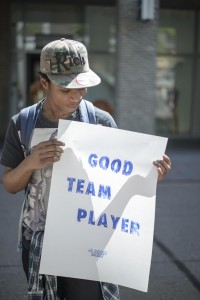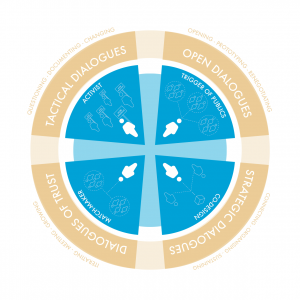De Andere Markt in Genk, Belgium exemplifies how designers in Genk research alternative futures for work through democratic dialogues with everyone involved. Together with Katrien Dreessen and Pablo Calderón Salazar of Social Spaces – LUCA School of Arts, Liesbeth Huybrechts (ArcK- UHasselt) writes about the participatory design approach and the various roles of the designers in the project.
The concept of ‘smart cities’ is gaining importance within different communities concerned with city-making and design (policy-makers, planners, IT-companies, etc.). Different definitions of ‘smart cities’ exist, although two perspectives prevail. One focuses on the production of services, technology and tools to optimise urban life. The other envisions alternative futures for urban development and the knowledge economy, cooperating with or organised by citizens [1; 2]. ‘De Andere Markt’ (DAM – Dutch for ‘The Other Market’), a collaboration between research groups in Design (LUCA School of Arts), Architecture (UHasselt) and the city of Genk, is situated at the intersection of both. It exemplifies how designers in Genk (BE) research alternative futures for work through democratic dialogues with citizens, public and private organisations by creating new scenarios, spaces and tools. The changing context of Genk after the closure of the coal mines in the 80s and Ford in 2014, provides a backdrop for the origins of DAM as a space where new issues and designs evolve from bottom-up, long-term participation between diverse communities [3].
Local youth embrace our venue as an experimental space e.g. for making music or handicraft.
Design approach
The approach of DAM is closely related to the Scandinavian tradition of Participatory Design (PD), which initially focussed on designing for democratic participation of workers in the development of the workplace [4]. Later as work became more intensely intertwined with communities, PD started to emphasize settings that include but also go beyond the formal organisational structures common to traditional workplace studies [5]. Technological developments, a diverse and competitive market, globalisation, ‘flexibilisation’ and privatisationprivatisation, have complicated the relationship between design for work, citizens and the city [6]. Whereas in the 70s most people were employed by large companies and institutions, working in monofunctional locations such as offices or factories, nowadays working arrangements have become much more flexible. Designers in the 70s therefore generally dealt with clearer organisational structures and problem statements, while designers today engage with more ill-defined problem settings, organisational contexts and design processes that are more dispersed over time and space.
Design roles and democratic dialogues
This complex context demands the collective articulation of designers and citizens’ diverse and often contradictory requirements in the form of dialogues [7]. In work-oriented PD, democratic dialogue was foregrounded in order to design alternative futures together with workers. An equal level of control defines democratic dialogue: everyone who is influenced by the design process can share control and direct the conversation with the designer [8]. These dialogues can be verbal but designers often materialise them via artefacts as subjects of conversation (scenarios), tools for conversation (posters, videos) or enablers of experience (interventions, prototypes) [9;10]. The dialogues designers engage in today are diverse and are associated with different designer roles: e.g. facilitator or ‘match-maker’) [11] ; instigator of ‘publics’1 [9; 12] ; co-designer [13] and design activist [14]. The research team at DAM makes the dialogues explicit, which support these roles in democratically designing Genk’s future of work, by using two core venues: a shop front and a cargo bike. The shop front in one of the main streets of Winterslag (Genk) is used as a means to make DAM visible and accessible at all times. The cargo bike is used to actively enter the different neighbourhoods of the city with DAM interventions. The following roles for designers and corresponding dialogues on alternative futures for work, were identified after analysing the research activities of De Andere Markt:

- The designer as an instigator of publics engages in open dialogue about diverse issues and agendas on work in the city. The DAM team intervenes in public space by using a cargo bike mounted with a DIY printing press, asking passers-by to visualize their skills in a poster and envision their importance in the future of work. Participants are encouraged to hang this poster in their work or living spaces, creating visual cues of the skills in Genk (Figure 1). The dialogues are designed to be as open as possible, acting as ‘prototypes’ of relationships between diverse stakeholders changing over time. These open dialogues provoke uncertainties and renegotiations between citizens, who have to adapt to more transparent and less goal oriented ways of working, and designers who often work behind closed doors [15]. For instance, at the start of DAM, policy-makers were regularly asking about the concrete outcomes of the interventions while DAM deliberately left their goals very open. It was only after a few weeks when these interventions resulted in small pilot projects that policy-makers started to feel more confident about their value.
- In order to tackle the potentially volatile nature of open dialogue, the DAM team adopts the activist-role to engage in more tactical dialogues, addressing the status quo on work. Historical data on work in Genk, the dialogues generated during the interventions and the analysis of these dialogues are documented and published in the shop front, on the streets and online to change the existing discourse on work; thus changing the status quo. For instance, many informal urban farming initiatives that were discovered during the interventions were publicly documented because they are inspiring to build upon when designing the future of work in Genk. This public documentation, and the debate it generates, leads to renegotiations between policy-makers and farmers on the contested role of these farms in the city.
An equal level of control defines democratic dialogue: everyone who is influenced by the design process can share control and direct the conversation with the designer.
- The designer as facilitator or match-maker engages in dialogues of trust characterised by their iterative and durational nature. Via iterative interventions, new publics are generated and existing engagements are strengthened. The shop front builds a durational dialogue between the actors by functioning as a meeting-place, an incubator for initiatives to grow and a physical connection with other initiatives on urban development in Genk. Local youth embrace our venue as an experimental space e.g. for making music or handicraft.
- The co-designer engages in strategic dialogues connecting the open and tactical dialogues with private or policy actors. For example, the city of Genk is developing plans for an old coal track. DAM’s role is to document and connect smaller work initiatives (e.g. the informal farms) together with this track and to connect existing policy or business initiatives within the city in order to design sustainable future workspaces.
Figure 2 shows the overview of the above-mentioned roles and dialogues.

Reflection
Design roles manifest themselves in relation to different moments and politics of a PD process. Therefore they need to be understood by taking into account the evolution in the design process and how actors in this process complement and conflict with each other. This became clear with the occasionally conflicting expectations between designers, citizens and policy makers. DAM initiated many open-ended and tactical dialogues where the design artefacts (e.g. public documentation of small farming initiatives) played an intermediary role. Sometimes this conflicted with expectations to present design artefacts immediately as results (e.g. concrete design proposals for self-sustainable city farms) in strategic dialogues with policy-makers. However durational and iterative dialogues of trust allow us to clarify the complementarity between the diverse dialogues for all parties involved.
The DAM team intervenes in public space by using a cargo bike mounted with a DIY printing press.
This typology of dialogues also opens up the different roles for discussion. For example, the design activist role regularly overlaps with the co-designer role [14], when the public documentation on informal work activities in Genk is actively used in workshops challenging the status quo perceptions on the future of work in the city. Engaging with the above-mentioned dialogues and roles thus allows us to transcend often-mentioned stereotypes and dichotomies, i.e. ‘top-down’ [17; 18] versus ‘democratic’ or ‘activist’ versus ‘co-designer’, in understanding and designing smart cities.
Footnote
- Publics refers to the work of Dewey [16], stating that many publics develop; each configurations of people that share a common issue of significance.
Literature
- Goodspeed, R. (2015). Smart cities: moving beyond urban cybernetics to tackle wicked problems. Cambridge Journal of Regions, Economy and Society, 8(1), pp. 79-92.
- Brynskov, M., Carvajal Bermudez, J., Fernandez, M., Korsgaard, H., Mulder, I., Piskorek, K., & De Waal, M. (2014). Urban interaction design: Towards city making. Neuhausen, Germany: Urban IxD Booksprint.
- Björgvinsson, E., Ehn, P., & Hillgren, P. A. (2012). Design Things and Design Thinking: Contemporary Participatory Design Challenges. Design Issues, 28(3), pp. 101-116.
- Ehn, P. (1988). Work-oriented design of computer artifacts. Stockholm: Arbetslivscentrum.
- DiSalvo, C., Clement, A., & Pipek, V. (2012). Participatory design for, with, and by communities. International Handbook of Participatory Design. Simonsen, Jesper and Toni Robertson (Eds). Oxford: Routledge.(2012), pp. 182-209.
- Graham, S. & Marvin, S. (1994). More than Ducts and Wires: Post-Fordism, cities and utility networks. In P. Healey, P. (ed) Managing Cities: The New Urban Context, London: John Wiley.
- DiSalvo, C., Lodato, T., Fries, L., Schechter, B., & Barnwell, T. (2011). The collective articulation of issues as design practice. CoDesign, 7(3-4), 185-197.
- Miettinen, R. (2004). The roles of the researcher in developmentally-oriented research. DEVELOPMENT INTERVENTION, p. 105.
- Manzini, E., & Rizzo, F. (2011). Small projects/large changes: Participatory design as an open participated process. CoDesign, 7(3-4), 199-215.
- Hillgren, P. A., Seravalli, A., & Emilson, A. (2011). Prototyping and infrastructuring in design for social innovation. CoDesign, 7(3-4), 169-183.
- Björgvinsson, E., Ehn, P., & Hillgren, P. A. (2010, November). Participatory design and democratizing innovation. In Proceedings of the 11th Biennial Participatory Design Conference (pp. 41-50). ACM.
- DiSalvo, C. (2009). Design and the Construction of Publics. Design Issues, 25 (1), pp. 48-63.
- Sanders, E. B. N., & Stappers, P. J. (2008). Co-creation and the new landscapes of design. Co-design, 4(1), 5-18.
- Lenskjold, T. U., Olander, S., & Halse, J. (2015). Minor Design Activism: Prompting Change from Within. Design Issues, 31(4), 67-78.
- Huybrechts, L. (2014). Participation is Risky. Approaches to Joint Creative Processes. Amsterdam: Valiz.
- Dewey, J. (1927). The role of philosophy in the history of civilization. The Philosophical Review, pp. 1-9.
- Carvalho, L. (2015). Smart cities from scratch? A socio-technical perspective. Cambridge Journal of Regions, Economy and Society, 8(1), 43-60.
- Kitchin, R. (2014). The real-time city? Big data and smart urbanism. GeoJournal, 79(1), 1-14.

